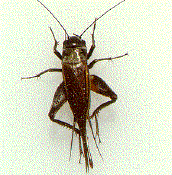

CRICKETS
Cricket outbreaks are one of the most predictable pest events of the year in most areas of Texas. Late summer and fall are when adult crickets become especially abundant around homes and commercial buildings. Although the cricket species associated with outbreaks in Texas have not been well-studied, most belong to the Gryllus assimilis complex, and are collectively referred to as black field crickets, or field crickets.
BIOLOGY
Field cricket eggs are laid in the fall, approximately two weeks
after females mature and develop wings. Firm, bare soil sites are preferred for
egg-laying. A single female cricket may lay from 150-400 eggs. Eggs remain in
the soil throughout the winter and hatch the following spring.
Cricket nymphs can be identified by the incomplete development of the
wings. Immature crickets require approximately three months to complete their
development and become adults. Once the cricket reaches the adult stage it is
capable of flight and mating. Cricket outbreaks occur when large numbers of
nymphs complete their development and embark on nighttime mating flights.
The largest cricket outbreaks seem to occur during years of dry springs
and summers. The reason for cricket outbreaks under such conditions is not fully
understood; however, less fungal disease among eggs and cricket nymphs may
provide a partial explanation. Although crickets can be locally abundant in any
year, numbers appear to be highest in August and September when a summer drought
is broken by rainfall and cooler weather.
DAMAGE
Field crickets are primarily outdoor insects, and as such are
only accidental indoor invaders. Nevertheless, they can become a considerable
household nuisance when abundant. Unlike house crickets (the species commonly
sold in stores as pet food), they will not breed or establish permanent indoor
infestations.
Indoors, crickets may damage clothing, drapes or wall coverings by their
feeding activities or by staining with their feces or regurgitations. Although
crickets do not normally feed on fabrics, soiled clothing or clothes stained
with perspiration may be damaged by crickets.
During severe outbreaks crickets can create an aesthetically
unacceptable situation around places of business. Dead crickets quickly pile up,
causing odors; and many people are repelled by the sight of large numbers of
crickets on walls and sidewalks around offices and stores.